 In another of a series of cases involving the application of the special appraisal provision for a dealer’s heavy equipment inventory to a lessor of natural gas compressors, the Tyler Court of Appeals has ruled in favor of an appraisal district that included compressors located in the county on the appraisal roll.
In another of a series of cases involving the application of the special appraisal provision for a dealer’s heavy equipment inventory to a lessor of natural gas compressors, the Tyler Court of Appeals has ruled in favor of an appraisal district that included compressors located in the county on the appraisal roll.
J-W Power Company v. Henderson County Appraisal District (No. 12-22-00325-CV; March 31, 2025) arose from a cluster of lawsuits brought in different counties by JWP, who owns compressors and leases them to producers around the state. JWP maintain storage yards in several counties from which it leases equipment in the surrounding region. One of those yards is located in Gregg County. As you may recall, in 2011 the Legislature enacted §§ 23.1241 and 23.1242, Tax Code, which provided for the appraisal of an inventory of dealer’s heavy equipment in the county in which the inventory was based and maintained. (The statute also prescribes a valuation methodology that several districts challenged as unconstitutional.) Taxpayers in the compressor-leasing business subsequently protested appraisals of their compressors based on the location of each individual compressor on January 1 of the tax year. That’s what JWP did in several counties, including Henderson Cental Appraisal District, which appraised compressors located in the county for the 2013, 2014, 2015, and 2016 tax years. HCAD denied the protests in each of those years, but JWP did not appeal any of them at the time.
After SCOTX’s decision in EXLP Leasing, LLC v. Galveston Cent. Appraisal Dist., 554 S.W.3d 572 (Tex. 2018), which upheld the statute’s valuation methodology, JWP filed § 25.25, Tax Code, motions to correct the appraisal rolls for the four years in question. It asserted that pursuant to EXLP, HCAD erroneously appraised its compressors, which should have been appraised as dealer’s heavy equipment inventory in Gregg County. It further asserted that the compressors had been taxed twice, once as business personal property by HCAD and once as inventory by G(regg)CAD. The ARB denied JWP’s motions. JWP sought judicial review, and both parties filed motions for summary judgment. The trial court ruled for HCAD. The court of appeals affirmed (as did several other intermediate appellate courts) on res judicata grounds. SCOTX reversed these decisions in EXLP and remanded for consideration of the merits.
In an opinion by Chief Justice Worthen, the court of appeals once more affirmed the trial court’s grant of summary judgment to HCAD. The first issue was whether HCAD’s appraisal of the compressors in the county resulted in multiple appraisals in violation of EXLP. To make its case, JWP reliedon a revenue spreadsheet for the applicable tax years that showed an average of more than two hundred compressors leased from the Gregg County yard in each year. JWP did not, however, proffer any tax statements for compressor leases for 2013 from GCAD, and for the subsequent tax years could only show that it reported two, thirteen, and twenty-nine leases, respectively. The spreadsheet did identify compressors appraised by HCAD as assigned to the Gregg County yard in all four years, but none of them were reported to GCAD in the statutorily-required monthly statements of revenue from the dealer’s inventory. JWP argued that it didn’t matter that the compressors weren’t reported to GCAD because they were part of the inventory actually appraised by GCAD. The court rejected this argument on the basis that § 23.1242(e) requires the monthly statements to include “a description of each item of heavy equipment sold, leased, or rented including any unique identification or serial number affixed to the item by the manufacturer[.]” JWP failed to account for each leased compressor in this way. The court determined further that GCAD did not appraise the compressors located in Henderson County for the relevant tax years because JWP couldn’t demonstrate that any it reported any of the Henderson County compressors as part of its inventory. The trial court, consequently, did not err when it concluded that HCAD was entitled to summary judgment on the multiple appraisals claim.
JWP tried another tack, arguing that HCAD improperly included on the appraisal rolls certain compressors that didn’t exist in the form or at the location described in the rolls under § 25.25(c)(3). The court disagreed, citing a long line of authority holding that a “form or location” challenge does not extend to propery that actually existed as personal property in the county at the time of appraisal. In other words, JWP asserted that the compressors did not exist in Henderson County because HCAD had no right to appraise them under § 23.1242. Its challenge thus resembled an allocation challenge to an appraisal district’s right to tax the proportionate value of the property that existed in the county for a part of the tax year. Section 25.25 does not provide an appropriate remedy for a case in which the personal property was physically located in the appraisal district at the relevant time.












